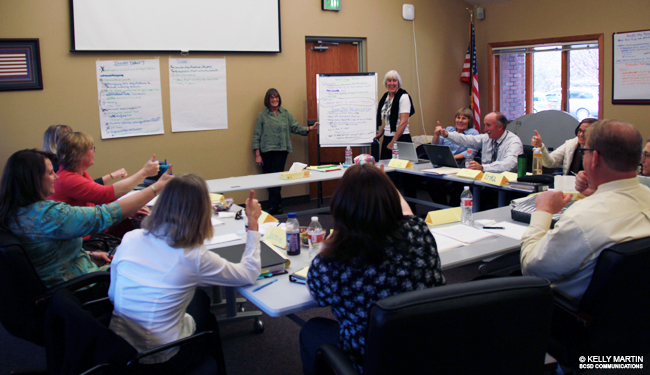Last July, it took a federal mediator to help forge a labor agreement in the Twin Falls School District.
This year, the district and the teachers’ union are engaged in a laborious process of crafting a deal on their own. They’ve come to terms on the non-financial issues, and are starting to work through money matters. The tone has been “respectful,” Superintendent Wiley Dobbs said Wednesday, and he is hopeful that a deal can be reached this month.

July 1 is deadline day for school districts: the day when 2013-14 master agreements expire. But in Twin Falls, and elsewhere, the process seems to be unfolding more smoothly this time around. Several larger districts already have 2014-15 deals in place. Negotiations are continuing in several other large districts — from Coeur d’Alene to Nampa to Pocatello.
All districts have a little bit more money to discuss. The 2014 Legislature approved a 1 percent boost in teacher salaries, although it’s up to individual districts to figure out how to divvy the money. (The Legislature also approved $15.8 million in teacher leadership “premiums,” to reward teachers who mentor, take on hard-to-fill jobs or take on other leadership roles; this money cannot be folded into the collective bargaining process.)

With the 1 percent increase in the salary pool, districts are looking at several options, including pay raises and one-time bonuses. Some districts are looking at putting money into the so-called steps and lanes of the teacher salary schedule — to fund pay increases based on experience.
The salary schedule is one point of discussion in Nampa — which only completed its 2013-14 agreement in February. District officials have proposed restoring 14 days to the school calendar — reversing the furloughs imposed to offset a $5.1 million shortfall — and funding one “step” in the salary schedule. Nampa Education Association negotiators have proposed funding four “steps” in the schedule.
After five negotiating sessions in Twin Falls, the parties will meet two more times in the next week. The district, like others around the state, is using an “interest-based” approach to bargaining. District and union negotiators lay out a list of interests they would like to see addressed in the process — and then they begin discussing what interests can be addressed and funded.
Sometimes those are competing interests. Union negotiators may want an increase in pay, or for the district to cover rising insurance premiums. The district may want to put some money back into reserves, to replenish funds that were drawn down during the recession. These interests are competing for the same finite pool of money.
But the pool of money is a little bit larger this year — and with that, Twin Falls went back to an interest-based approach that was jettisoned during the Recession. When dollars were tight during the downturn, it was almost a moot point to discuss interests such as pay raises or building reserves. “We didn’t have any money to fight over,” Dobbs said. “We were in a cut mode: ‘What are we going to do to meet the level of cuts that we’ve received?’”
Here’s a rundown of some deals in the works statewide:

Meridian: The state’s largest district and the local teachers’ union already have a 2014-15 deal in place; the school board approved it Saturday and teachers followed suit Tuesday. The agreement includes a 1 percent increase in the salary base, and pay raises for teachers who advance on the salary ladder. The district also agreed to cover a 4 percent increase in health insurance premiums.
The early settlement is a marked departure from last summer — when the School Board declaring an impasse in negotiations after the July 1 deadline came and went without a deal.

Boise: The district announced its deal last week; it received unanimous support from the school board and 95 percent ratification from the Boise Education Association. Highlights include a 1.5 percent increase in base pay and a .5 percent one-time payment to employees.
Like Twin Falls, Boise employs an “interest-based” negotiating tack. “This process has proven to be highly effective both at the bargaining table and in building our collaborative relationship to address issues affecting the district and its educators,” Superintendent Don Coberly said last week.
Caldwell: After a lengthy interest-based bargaining process — 16 sessions stretched across 50 hours, according to Superintendent Tim Rosandick — the district and the teachers’ union have a tentative agreement in place.
The agreement includes a 1 percent pay raise.
Vallivue: Negotiations went smoothly, Superintendent Pat Charlton said, yielding an agreement after only two sessions. The deal includes a 1 percent boost in base pay, allows raises based on movement within the salary schedule, and provides a $500 bonus for veteran teachers who cannot move within the salary schedule. (More details from the Idaho Press-Tribune.)
Idaho Falls: On Wednesday night, the school board approved the 2014-15 agreement, already ratified by the union.
The agreement includes a 1.07 percent boost in teacher compensation — a stipend for professional development. In December, all teachers will receive a one-time, $150 bonus.
Post Falls: An agreement was reached last week, according to the Coeur d’Alene Press. It includes a 1 percent pay raise and unfreezes the salary schedule, allowing raises based on experience.
Blaine County: The district and the teachers’ union came to terms in May. Certified teachers will get a 1.25 percent increase in base pay, and in December, they will receive a one-time payment equaling .25 percent of pay. The district agreed to absorb the increase in health benefit costs. (More details from the Idaho Mountain Express.)
